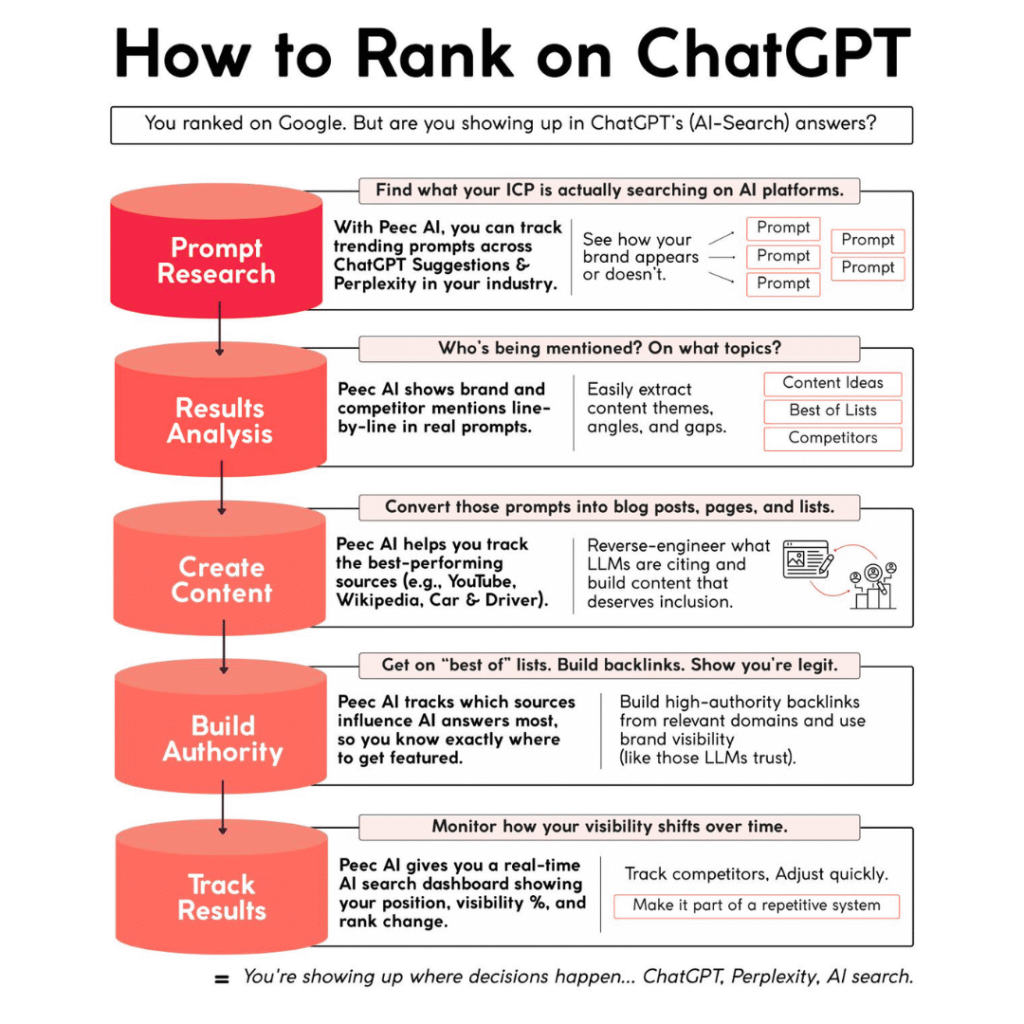Most brands have no clue how to rank on AISO (AI Search Optimization) ; they’ve already missed the next traffic wave. They’re optimizing for Google rankings while AI tools like ChatGPT, Perplexity, and Google’s AI Overviews quietly rewrite the rules of visibility.
If you’re not part of the sources AI pulls from, you’re not part of the conversation. And that means your brand is missing out on visibility, clicks, and qualified leads.
AI tools like ChatGPT, Claude, and Perplexity now serve as discovery engines for millions of users. People aren’t just searching, they’re prompting.
They’re asking nuanced questions, comparing options, and looking for simplified insights. And if your brand doesn’t appear in those answers, the trust transfer goes to someone else.
The truth is ChatGPT doesn’t invent answers. It pulls from real sources blogs, citations, listicles, and domains it considers trustworthy. If your brand isn’t being cited, your audience won’t find you, no matter how good your product or service is.
That’s why forward-thinking brands are now building for AI visibility by design, not by chance. Here’s how they’re doing it and how you can too.

First, they start with Prompt Research.
Instead of guessing what their audience might search for, they look at the actual prompts people are using in AI tools. These are often different from what users type into Google. AI searchers are more conversational and context-driven. Think:
- ● “Best tools for managing remote teams in 2025”
- ● “Alternatives to HubSpot for early-stage startups”
- ● “What’s the difference between SEO and AEO?”
- ● “How do I get my product ranked in ChatGPT answers?”
These prompts aren’t theoretical. They’re real, measurable, and trending. Smart brands track them using prompt monitoring tools and category-specific insights. Then, they check if their brand is part of the responses or missing entirely. This alone can be a wake-up call.
Next comes Results Analysis
This is where strategic clarity begins. Brands dig into which sources, formats, and domains are getting cited by AI tools. They reverse-engineer what’s working:
- ● What types of articles does ChatGPT quote?
- ● Which “best of” lists show up repeatedly?
- ● Which domains does Perplexity consider reliable?
- ● How often is your competitor mentioned?
You’ll notice something interesting here: the same brands tend to show up over and over. It’s not because their content is flashy—it’s because it’s clear, structured, and valuable. These are the traits LLMs prioritize when deciding what to include.
If you’re serious about showing up in AI answers, then knowing what the LLMs reward is crucial. Once you find the gaps—topics not covered well, citations missing depth, categories where your brand should dominate—you move to the most critical phase.
Create Better Content
This is not about “more content.” It’s about making high-value content that serves both humans and AI. You take what prompt research uncovered and what your analysis revealed, and then:
- ● Turn prompt data into blog posts, explainers, and landing pages
- ● Structure them with clarity: headings, bullet points, answer-first formats
- ● Use trustworthy sources and internal linking that makes sense
Don’t write like you’re just blogging. Write like you’re teaching a machine what your brand is the authority on. The more specific, structured, and human-first your content, the more likely it is to be included in AI responses.
Then, Build Authority
This part separates the content marketers from the AI visibility strategists. You can’t just publish content—you need to feed it into the right ecosystems. LLMs pull heavily from:
- ● “Best of” listicles
- ● Comparison articles
- ● FAQ-rich resource pages
- ● High-domain-trust blogs and publishers
Get your brand listed in third-party roundup posts. Contribute guest content to domains already cited by ChatGPT. Work with creators and platforms that already influence AI visibility. Earn backlinks from pages that are part of the LLM trust web.
Remember, authority in AI search is about credibility, not volume. One well-placed “Best CRM for Startups in 2025” feature on a trusted domain can do more than 50 random backlinks.
Once you’ve planted the seeds, you need to Track Results.
AI visibility isn’t static. Models update. Prompt behaviors shift. Content ages. That’s why the smartest brands treat this like a channel not a campaign. They:
- ● Monitor which prompts their content appears in
- ● Track rankings and citations across tools like ChatGPT, Claude, and Perplexity
- ● Watch how competitors gain or lose ground in AI visibility
- ● Adjust strategy with data, not assumptions
This level of tracking turns AI search into a repeatable, predictable traffic source. It also means you stop wasting time hoping your 300th blog post ranks and start building a machine that fuels ongoing authority and lead generation.
Now here’s the part that most brands miss entirely:
AI search isn’t just another version of Google.
According to the latest insights from Originality.ai, 90% of ChatGPT’s citations come from content ranked outside Google’s top 20. That’s a huge shift in how trust is assigned.
What that means is AI tools aren’t just favoring top-ranking SEO pages. They’re favoring clarity, usefulness, and structure even if the content is sitting on page 5 of Google. This creates a massive opportunity for brands that previously couldn’t compete with enterprise SEO budgets.
Now, anyone who builds smart, human-first content with the right structure can win.
But it won’t happen by accident.
You need to:
- ● Research real prompts, not just keywords
- ● Study what LLMs actually cite
- ● Create better content with purpose and structure
- ● Build authority in the right ecosystems
- ● Track performance and adapt
You won’t rank in ChatGPT by chance. You’ll rank by design.
So the real question is:
Is your brand optimized for the future of search?
Or are you still chasing Google traffic while AI routes around you?
Want to find out where your brand stands? Start with a Brand Visibility Audit with DDefinition See what’s showing up, what’s not, and what to do next.
Because if you’re not showing up today, someone else is taking your spot tomorrow.
Clarity over content. Strategy over scramble.
And if you do this well, AI search becomes more than just a traffic source it becomes your brand’s trust engine. It influences decisions, builds credibility, and positions your brand as the expert in your space.
![[Transparent]New FInal white Font](https://ddefinition.com/wp-content/uploads/2025/07/TransparentNew-FInal-white-Font.png)






